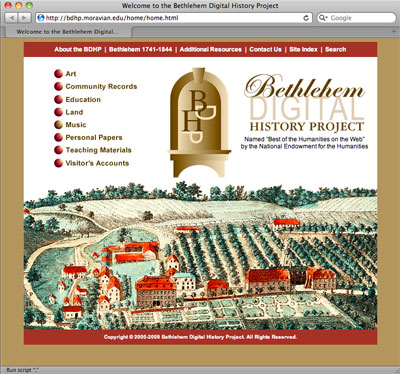The Bethlehem Digital History Project

http://bdhp.moravian.edu/home/home.html
The Bethlehem Digital History Project (BDHP) is a model of scholarly and institutional collaboration. With its vast online repository of manuscripts and images, it makes an important contribution to the study of Moravians in early American history. While it focuses on the settlement in Bethlehem, Pennsylvania, 1741-1844, the project tells a larger story about the cultural transformations that took place from the colonial period to the mid-nineteenth century. Boasting an impressive list of consultants and contributors, the site has something to offer scholars, teachers, and students.
On its front page, the BDHP presents eight categories of source materials, including essays, documents, and images. The “Community Records,” “Education,” and “Personal Papers” categories are the strongest, with a generous sampling of sources. Digitized manuscripts are well organized, and in many cases, photos of the original documents allow closer examination. The site offers German transcriptions and English translations for much of the material. A number of documents in a section entitled the “Scholars Corner” are in German script only.

There are challenges involved in organizing so much material into a compact organizational scheme on a Website. Though site navigation is mostly clear, there are some user-interface (UI) issues as one goes deeper into sections. When viewing a single manuscript, for example, the visitor encounters no markers providing orientation with respect to the rest of the site. Implementing breadcrumbs at the top of the page would help in this regard. Drop-down menus also might provide greater ease when jumping from one sub-section to another. The “Site Index” page could serve as a tool for navigating through the content, but it seems more likely to be a useful reference for conceptualizing the site as a whole. Further complicating user experience, the top-level navigation menu bar alternates randomly between the left and right columns on various pages; there are also different design templates used for no apparent reason on various parts of the Website.
These minor UI quibbles aside, there is enough material here to satisfy the casual visitor and whet the appetite of a more serious researcher. Selections under “Community Records,” for instance, run the gamut from diaries to store inventories to meeting minutes. The choir diaries with brief excerpts give a snapshot of life in early Bethlehem, whereas the communal diaries of 1742-1763 provide a more panoramic sketch. Thanks to the scrupulous record-keeping of clergy, the marriage registers include detailed information about inhabitants’ provenance, relationships, vocational ventures, and death. The result is a striking 150-year biographical history of the people of Bethlehem that traces desertions, migrations, and other sundry details of community life. Even the gap between December 1775 and August 1778, a period of war and tumult, reflects dislocations in the broader American context. These documents also reveal the changes and challenges the Bethlehem Moravians experienced as they moved from a communal economy to a cash economy oriented around individual families.
The Website provides a taste of the abundant repository of sources available at the various Bethlehem archives. Such is the case with the section on education. From austere boarding school rules and startlingly pointed hygiene instructions to documents relating to the Moravian College and Seminary, we glimpse the community’s concern for the care of its children and youth.
The documents are similarly wide-ranging in the “Personal Papers” section. Divided into journals, letters, and memoirs, this part of the site displays excerpts of English translations, with longer German versions also available. The “Memoirs” sub-section contains thirty-four documents with colorful descriptions of the diverse lot of people who made Bethlehem their home. For example, we can read about the life of Irish-born James Burnside, who served at George Whitefield’s Orphan-House in Savannah for a time before landing at Bethlehem as a Moravian convert. Of the thirteen women represented here, Elizabeth Horsfield stands out as someone who could trace her lineage to the Huguenots during the reign of Louis XIV, was baptized in an Episcopal Church in Philadelphia, and made the choice to leave her parents and join the Moravians in June 1775 at the age of twenty-one. One minor complaint is that the memoirs are listed alphabetically by name, which seems a less-than-ideal way to do it. More helpful would have been a chronological ordering, with perhaps birth years printed alongside the names.
Though the scantly populated “Art” and “Music” sections pale in comparison to the abundance of manuscript material elsewhere on the site, these areas still provide a number of pictures well-chosen to furnish the imagination. Some of the images, however, would benefit by increased resolution, as is particularly the case with vivid pictures of drawings and needlework.
In the final analysis, the Bethlehem Digital History Project is a remarkable achievement. Sponsored by the Bethlehem Area Public Library and the Reeves Library of the Moravian College and Theological Seminary, with participants including the Moravian Archives, the Moravian Historical Society, and the Historic Bethlehem Partnership, the BDHP site makes available a treasure trove of information that spans over a century of Moravian community life in Pennsylvania. With Boolean search capability, links to external teaching resources, and a wealth of digitized primary source materials, the site offers visitors much to explore. The ability to obtain a bird’s-eye view of multiple sources for study and comparison, to drill down into particular details and back again, and to make rare primary sources widely available are some of the most compelling advantages of digital history—and the BDHP shines in all these respects.
Peter Choi is a doctoral candidate in American history at the University of Notre Dame, currently working on a dissertation on religion and empire in the eighteenth-century British Atlantic world.